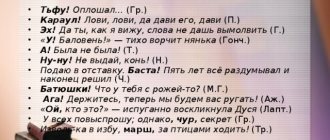When oral speech suffers, everything is clear, a speech therapist is required. When written language suffers, you need... what? Severe punishment for lack of diligence? Or “you just need to teach better,” as liberal-minded parents say?
Sometimes it’s “better to teach.” And sometimes - both to teach and to heal a little. And in general, you will have to turn to a speech therapist (yes, and with written speech too) so that he can figure out whether emergency speech therapy help is needed. Some parents are very surprised when the school advises them to check with a speech therapist. And they are even more surprised when the speech therapist advises to work out. And under no circumstances should you use a belt or other medieval methods of influencing a person. The speech therapist also says the word dysgraphia, which means a disorder of written speech.
What is dyslexia
Albert Einstein, Walt Disney, Keanu Reeves and Vladimir Mayakovsky - it would seem that what could these people from different eras and professions have in common, except that many people on the planet know their names? All of them faced dyslexia, which did not prevent them from achieving world fame.
Dyslexia is not a disease
Dyslexia is not a disease or lack of intelligence. A feature of the brain that prevents its owner from perceiving information the way ordinary people do. It is expressed in different forms, the main of which are:
- difficulties with reading skills;
- problems with writing skills;
- difficulties with grammar;
- periodic impairment of motor skills and coordination;
- poor concentration.
Dyslexia was first identified at the end of the 19th century in Germany. Ophthalmologist Rudolf Berlin described the symptoms after working with a young patient who had no difficulties with communication and physical development, but was completely unable to comprehend grammar and reading. The doctor attributed the deviation to visual pathologies.
In 1925, the theory was refuted by neurologist Samuel Orton, according to his research, dyslexics had asymmetry of the brain lobes. This statement also turned out to be false, and only in the 1970s did scientists agree that dyslexia manifests itself in people with poor metaphonological and phonological development. That is, due to a failure in the process of acquiring adult speech patterns. During the period of early development, each child gradually masters speech skills; at first, they do not finish words, confuse syllables, or express thoughts unclearly. As most people get older, their neurons overcome this and speech becomes clearer. Later, they find it easier to write and read, unlike dyslexics.
The child masters reading skills
According to research, patients with dyslexia:
- have an active right hemisphere of the brain;
- have differences in the weight of the hemispheres;
- most have experienced birth trauma;
- have experienced a head injury;
- suffered a dangerous infection (for example, meningitis);
- suffered from infections in the womb (measles, rubella, herpes) or gave birth to a dependent mother.
The manifestations of deviation are aggravated by: lack of pedagogical education, lack of communication, destructive environment, physical isolation (which threatens complete loss of speech, with a healthy brain and normal physical development). Dyslexia is 5 times more common in boys than in girls. This is a feature that lasts a lifetime, but its manifestations can be corrected and the child (or adult) adapted. The sooner it is detected, the easier the measures taken will be assimilated by the brain.
Diagnosis of dysgraphia
By what signs can you guess that a child has dysgraphia? First of all, if he makes mistakes when writing... let's say, strange ones. They are not associated with violation of grammatical rules. It is impossible to find rules for these errors. Errors occur in completely innocent words, the spelling of which does not allow for ambiguity.
Instead of “house” he writes “don” or “tom”, instead of “for” he writes “dyal”, instead of “cat” - “who”, instead of “came” - “sat down”, “squirrel” turns into “block” and so on Further. The child may not complete words, insert extra letters, or skip them.
One 11-year-old boy wrote during the examination: “The girl hid in a tree.” The phrase was dictated to him: “The squirrel hid in a hollow.” When asked how we write prepositions, the sufferer answered correctly - “separately.” He knows the rule, but cannot apply it in practice.
But this child is not bad, not stupid, he is very nice. He just has a hard time writing. Only special exercises and self-confidence can help.
People with dysgraphia often have very poor handwriting - small or very large, illegible. It’s hard for a child to follow the line, the words run into the fields, onto each other, slide off the line or suddenly fly over it, the word is free birds. Also, young dysgraphics do not complete endings. They may write in a mirror way, turning the letters over, they may not complete certain elements of the letter or they may add extra ones.
When a child is just learning to write, he may still have such strange mistakes at the very beginning of his learning, but they quickly disappear. A person with dysgraphia is very slow to master literate writing. One gets the feeling that he is uncomfortable writing, he doesn’t like to do it. And indeed it is. Often, a schoolchild seems scared by the sheer volume of what needs to be learned, read, and written. And when they also scold you for failures, you completely give up.
Symptoms of dyslexia
Most often, parents notice the first signs of dyslexia, since it does not cause inconvenience to a child under 4-5 years of age. If 5 or more signs from the following list coincide, consultation with an experienced neuropsychologist and speech therapist is required.
Problems communicating with a child
For preschoolers:
- communication problems;
- late speech;
- incorrect placement of a pencil or pen in the hand after repeated training;
- has difficulty understanding new words and problems with their pronunciation;
- disordered sequence of words in speech and on paper, rearrangement of letters;
- difficulties with basic principles of letter writing and reading.
In everyday life, you can notice sloppiness in drawing, especially when working with coloring. A child cannot remember where is right and where is left; it is difficult to teach him to understand the time on a clock. He cannot name consecutive months or seasons, misses endings in words, and adds non-existent letters. There are great difficulties with tying shoelaces or fastening buttons. Of course, these signs must be consistent with the child’s age; accurate diagnosis is only possible through testing by specialists.
The child does not understand arithmetic
Obvious signs appear by the 5th grade of school:
- changes the words he reads to ones that sound similar;
- rearranges letters and syllables when reading;
- does not understand what he just read;
- confuses numbers and arithmetic signs;
- does not remember simple concepts well;
- cannot concentrate, is constantly distracted;
- behavior is awkward, clumsy, impulsive;
- perceives information slowly;
- coordination is impaired.
You can notice how the child involuntarily swaps syllables when reading; he is restless and impatient. When doing homework, he constantly dangles his leg or fidgets, standing up and sitting down. Loses things, forgets requests or what was said a few minutes ago. Often the behavior of a small person is associated with laziness and banal bad manners, but this is a mistake.
Adults have similar symptoms, which they often mistake for their own stupidity or absent-mindedness. Dyslexia can bring many difficulties, for example, the inability to read even a short note normally, poor memory for events and faces, problems with writing and counting.
Dyslexia causes many problems in life
“Doctors discovered that I had dyslexia when I needed a prescription for glasses. During the examination, I was given huge glasses with one red lens and the other blue. They asked me to read a passage and then asked 10 questions about what I had just read. I could only answer three. They studied how my eyes move while reading. It turned out that I read four words, then go back two. I didn’t read some words at all.”
Jennifer Aniston, source: Instagram.
Treatment of dysgraphia
It is better not to try to cope with all problems at once.
You need to choose one and focus on it. For example, a child confuses b-p, d-t, and also confuses prepositions with prefixes. If you take on everything at once, the amount of work can be daunting. But if you try to cope only with b-p, and then draw the student’s attention to the fact that, they say, there are fewer mistakes, then you can awaken enthusiasm. And the struggle for universal literacy will continue to be much more fun. A speech therapist at the clinic will be able to, with a timely visit (at three years old, at five years old and before school itself), determine whether there are any speech therapy problems that will later result in dysgraphia, and, if necessary, recommend special classes. The speech therapist may be joined by a neuropsychologist and a neuropathologist.
I often see very sad children at receptions. They frown when they are asked to write a dictation and immediately admit that they are “bad students.” Then, to cheer them up, I begin to remember various famous people who were also not friends with writing and reading. Maybe a modern child will not be interested in learning that Sergei Rachmaninov, Nikola Tesla, Albert Einstein, most likely, were also dysgraphic, but I think almost any boy will be touched by the information that the great Neo, the winner of the terrible Agent Smiths from The Matrix ”, also had difficulty coping with letters and words in childhood. Well, or rather, actor Keanu Reeves. I usually tell girls about Agatha Christie. Despite the fact that the creator of Poirot and Miss Marple studied poorly and wrote with errors, she became a famous writer. The main thing is to believe in yourself.
Types of dyslexia
The concept of this deviation is broad, as are the symptoms. Based on the signs that appear in a child or adult, one can determine the specific type of dyslexia.
Typology of features in manifestations:
- Tactile. It occurs in blind people who, while reading Braille with their fingers, jump from one line to another, go back, or read in reverse order.
- Mnestic. Difficulties in understanding speech addressed to dyslexics. Inability to fully perceive information by ear.
- Semantic. Does not understand the essence of what he read, although he may have perfect reading skills.
- Ungrammatical. Incorrect word placement, mistakes in endings, pronounces gender, tenses incorrectly (“white horse”, “I want to go to the store”);
- Optical. When a dyslexic person reads, his eyes jump from line to line and move in the opposite direction, the brain equally perceives letters that are similar in spelling (for example, “m”, “sh”, “i”).
- Acoustic. It can often be found among primary school students when words are replaced by similar-sounding ones or syllables are rearranged (for example, cat-mole-cake-tot, pine-pump).
Despite their special perception of information, dyslexics often have a talented and inquisitive mind. They think differently, have a developed imagination, and look at standard things from an unusual perspective. Many artists were born with this feature, including Leonardo da Vinci and Quentin Tarantino.
Dyslexia: a disease of geniuses or lazy people? Let's understand its causes and symptoms
If your child reads poorly, is completely illiterate and is also very absent-minded, do not rush to scold and criticize. Perhaps he has dyslexia. We talk about the reasons for its development and how to help the child with representatives of the private public initiative “Dyslexia Belarus”.
What is dyslexia?
Experts call dyslexia difficulty in mastering reading and writing. The disease is congenital. Due to a lack of knowledge, parents often confuse their child's peculiarity with ordinary laziness or low intelligence. However, this is a feature of the neurophysiological development of the brain.
Sometimes dyslexia can be acquired. For example, as a result of brain injuries. Then the prefix “a” is usually used in the word: dyslexia - alexia, dysgraphia (inability to master writing) - agraphia.
According to world research statistics, every tenth person suffers from dyslexia. The disease is typically difficult to diagnose, leaving more than 700 million people illiterate and socially isolated.
However, with timely correction and early diagnosis of the problem, 90% of dyslexic children can study in a regular school.
What symptoms indicate dyslexia?
- The child does not like to read fairy tales. He prefers encyclopedias with organized information to them. Dyslexics have a more difficult time remembering the plot of works. After reading the second paragraph, they may already forget the content of the first.
For such children there are no adjectives or adverbs. They have difficulty understanding abstract words. They more easily remember nouns that denote objects that can be touched.
- A child with dyslexia may miss pauses at the end of sentences and read text without punctuation. He also lacks intonation.
- The child has impaired working memory. For example, you can ask him to repeat three numbers, but in reverse order. This will be difficult for a dyslexic person to do.
- If you knock on the table at certain intervals, children with the described feature will not be able to repeat the rhythm.
- It is difficult for a child to read words with three consonants: look, splash.
- Dyslexics have poor coordination. It is difficult for them to catch the ball or perform manipulations with their hands, for example, to make a “Batman”.
- At the age of 8, such children can ignore lines, read from left to right, confuse similar letters “a”, “o”, “i”, “u”, in English - the letters “b” and “d”. Dyslexics do not remember vocabulary words.
- Dyslexia is often accompanied by dyspraxia, a lack of coordination. In this case, children may hit corners and walls. Their movements are awkward. It is difficult for a child to handle the office: pencils always fall out of the pencil case, for example.
- The child begins to have severe headaches when reading from overexertion.
- Children with dyslexia may hold a pen incorrectly. This is a signal that the brain is not yet ready to master writing skills.
When to sound the alarm
A specialist can diagnose “dyslexia” only after two years of teaching a child to write and read, that is, in grades 2–3. It is during this period that the load on him increases, an evaluation system appears and the pace of learning accelerates, to which it is difficult for the student to adapt.
Sometimes professionals can identify a predisposition to dyslexia with 100% probability in a child as early as 4 years old. If you detect a problem at this age, you can more effectively and quickly help your child navigate and gain reading skills at a low standard level before the start of active study. With early correction, there is every chance of achieving a level of mastery of the Russian language of 7 points. At the same time, the student will feel much more confident among his peers.
What to do if your child has symptoms of dyslexia
First, you need to contact the Center for Corrective and Developmental Training and Rehabilitation (CDDT), where specialists will examine the baby to understand what caused the disorder.
For example: if a child does not see a line, the culprit may be astigmatism (a vision defect in which the shape of the lens is distorted), physiological problems, or prolonged interaction with a smartphone.
To correct dyslexia, professional speech therapists, speech pathologists, clinical psychologists, and neuropsychologists are needed. Specialists practicing general psychology will not be able to help: they have not studied the structure of intelligence, the consequences of damage to areas of the brain or their dysfunction.
Depending on the type of problem, specialists decide how the child should learn and how his knowledge will be assessed. If a student, for example, is unable to learn vocabulary words, teachers may be advised to change the questioning method. Dyslexics often do not distinguish between hard and soft signs - the teacher can make allowances for this feature when checking dictations.
In any case, specialists must determine the level of relaxation in assessing a particular student after analyzing psychophysiology. And under no circumstances should parents or teachers. Also, professionals can advise a student to use a laptop when taking notes in physics and chemistry.
A timely examination will also help to avoid some secondary problems, for example, dependence on the assessment of others, timidity and shyness.
A well-developed staff of school psychologists would provide significant assistance in disseminating reliable information and helping parents and students. It is advisable that a professional work with the child in special integrated classes.
What can a family do to help a child?
- A mandatory quality for parents of a dyslexic student is patience.
Such children begin to evaluate themselves through the quality of their work. They think: “I will work well, then people will love me.” Because of this, they develop workaholism and, as a result, burnout.
- You need to switch to audiobook format. Dyslexics may not hear endings, so they often skip them and “swallow” them. They need to play audiobooks at a slower speed to make listening more comfortable. It is also advisable to read the educational material out loud.
To ensure your child understands the paragraph in class tomorrow, read it with him tonight. Go to online lessons that allow you to work with information in a condensed version. Such methods will help the child perceive the teacher’s words more easily, and he will feel more comfortable.
- Watch more films and cartoons together. At the same time, serial cartoons with simple phrases and non-speaking characters who communicate using onomatopoeia are contraindicated for dyslexics.
The most useful way is to watch a full-length film with a discussion. It is necessary to ask the child to retell so that he develops oral speech. This promotes the development of good reading and writing.
- With dyslexia, it is difficult to comprehend texts with a large number of archaisms and words with three or more consonants. The child will not read them, so it is advisable to work with texts that are “full vowel” - with the so-called “akaniya”. Epics are suitable for this purpose. They are melodious and can be tapped.
- Children quickly begin to read when they tap out a rhythm to themselves, for example, with a ball.
- The main thing is to show your child that he is a genius. Try to highlight his strengths. Then you will get a certain balance: the child will accept that he is talented and understand: “Yes, my grades are from 1 to 2. Well, you said that this is because of slowness. That’s what I’m working with.” In this case, the child accepts his quality and does not consider it a shortcoming. The genius of a dyslexic schoolchild is not discussed, but only the scope of its application: director, commander or artist. Inflated self-esteem is a must, then the impact of the disease is minimized.
- You can correct dyslexia through your favorite activity: sports, cartoons. Don't demand too much from your child. On the contrary, we need more support.
- If a student finds it difficult to write notes, they can be replaced with comics. For example, read a text, and the child will visualize it on paper.
- Help your son or daughter develop vocabulary. This will make it easier for them to remember the text and not feel constrained when retelling.
How the number of dyslexics varies by language
The more complex the language, its rules, and the number of unpronounceable consonants in words, the more dyslexics there are among users. It is easier for children with such features to learn Belarusian, Russian, Italian, and more difficult for them to learn French, Chinese, and English.
Is it possible to help adults with dyslexia?
Dyslexia can be corrected at almost any age. The main thing is that a person has a hobby through which he can influence even an adult.
Dyslexics are very talented
And it is true. Children with dyslexia try to use their strengths. The genius Leonardo da Vinci is often included among those suffering from this disorder. But this is more of a commercial move for motivation: “If he could do it, then you can too.” However, there are a lot of celebrities and truly talented people with this disease. Among them are cult directors Steven Spielberg and Quentin Tarantino. The second one, by the way, didn’t even finish school.
Dyslexia did not prevent actresses Keira Knightley and Jennifer Aniston from becoming famous. In the post-Soviet space, dyslexic celebrities include director Fyodor Bondarchuk, writer Evgeny Grishkovets and scientist and psychiatrist Andrei Kurpatov.
Daria ZIMAK
Photos by the author and from open Internet sources
How to Identify and Assess Dyslexia
How parents can check their guesses on their own:
- ask to find a letter in the text;
- pronounce a combination of letters;
- cut a letter out of paper;
- trace the outline of the picture;
- ask to find the missing letters in the alphabet or in a word.
The first step to making a diagnosis is to visit a pediatrician (or a general practitioner for adults). He will look at the signs, based on which he will refer you to a speech therapist and neurologist. Subject specialists will test the level of mastery of writing, reading, the ability to correctly express thoughts and perceive information in different ways. Using special equipment, the condition of hearing, vision, and the structure of the speech apparatus is checked. The neurologist will analyze the EEG and EchoEg, they will identify features in the structure of the brain.
Schoolboy
Once dyslexia is identified by specialists, there is no need to panic. This feature does not in any way affect the development of intelligence, mental or physical capabilities.
Causes of the violation
It is quite difficult for children to learn to read and write. During training, 4 analyzers are used:
- Speech motor - responsible for the correct pronunciation of words and sounds.
- Speech-hearing - responsible for determining and selecting the desired sound.
- Visual - determines the desired letter.
- Motor - determines how to write a letter correctly.
The development and formation of speech, the ability to correctly pronounce all sounds, the perception and reproduction of words - all this fully influences the process of a child learning to write and read. The parieto-occipital-temporal region of the brain is responsible for speech and writing, which is fully formed only by the age of 10 years.
It is especially difficult to learn to read for children who are diagnosed with problems with pronunciation and in distinguishing sounds that are similar in sound. This is due to the child’s underdeveloped phonemic processes, as a result of which he simply does not know how to pronounce the problematic sound correctly. Therefore, a child with such a disorder should not be taught to read and write until a specialist has formed his correct sound pronunciation.
There is also a special vision for letters. Simply seeing well is not enough to learn to write. With the help of this feeling, the baby learns to remember and then correctly reproduce letters. He must be intellectually developed, have good speech hearing and vision so that the process of learning to write and read is not particularly difficult.
The appearance of such problems can be influenced by the physiological characteristics of the child. Sometimes a disorder occurs associated with uneven development of the brain hemispheres, as a result of which the less developed part of the organ will perform its functions worse. In each hemisphere there are centers that are responsible for different capabilities of the body (reading, speech, vision, hearing, smell).
Often parents are faced with the problem of mirror spelling of letters. There can be many reasons for this feature, but most often speech therapists diagnose left-handedness. A person can be a hidden or obvious left-hander, and such people are characterized by mirror writing.
There is a hereditary tendency to rearrange letters when reading. If parents or other close family members have had difficulty learning to write or read, there is a good chance that the child will also have difficulty learning to read or write.
There are cases when the problem goes away on its own, the child outgrows it and continues to study normally without outside help. But there are other situations in which the problem starts and a person experiences serious difficulties already in adulthood. The video below shows a similar story:
A number of physiological and genetic disorders can also be the cause. At the same time, the person has normal mental development. He may be successful in any field of science, but he will have big problems with writing and reading.
Dysgraphia and dyslexia can appear in stubborn children when there is no harmony and connection between mother and child in the family. For example, if a baby is force-fed, against his wishes, in the future he will refuse to study, resist the teacher and mother, thus expressing his protest.
If a child has problems with concentration, then when reading it is difficult for him to follow the line. The consequence, again, is the rearrangement of letters in words and words in sentences. You should train the ability to concentrate attention on objects and do exercises for your visual muscles.
Dyslexia correction methods
It's sad but true - dyslexia will be with a person all his life and he needs to adapt to living with this feature. It is more effective to begin correction in childhood, while the brain is in the growth stage. Therefore, it is so important to conduct an early diagnosis and take action on time.
Schoolboy reading
The main task: to teach a dyslexic to recognize words, depending on the type of specific deviation (written, or in speech, etc.). There is no single method for correcting deviations; each case is individual and methods must be selected individually. The work is carried out gradually, step by step, the method depends on the type of dyslexia:
- For tactile, spatial imagination is developed, a gradual explanation of the essence of perceived objects and patterns is carried out.
- For mnestic, the development of auditory memory, visual perception of letters and spelling of words is carried out.
- For semantic, understanding of syllables, clarification of concepts, development of vocabulary are developed, and work is carried out to master the norms of grammar.
- For agrammatic, grammatical schemes and the concept of changing words and endings are formed.
- For optical training, visual analysis, spatial imagination, analysis of incoming visual information and its processing are trained.
- For acoustic methods, sequential perception and recognition of information by ear, repetition, and memorization.
In general, the correction comes down to the fact that the dyslexic must grasp his state and direct himself through actions in order to achieve the desired result (perception of information). People with special needs have a very developed spatial imagination, which is what experts suggest using in the correction process.
Forewarned - almost forearmed
It is better to prevent dysgraphia at an early age, without waiting until problems suddenly arise in the second or third grade, and the child develops an aversion to studying. You should keep an eye on the child and closely monitor the process of mastering written language:
- if the child attended a speech therapy kindergarten;
- if there was a delay in speech development at 2–3 years of age;
- if the child has problems with memory and attention;
- if the child is left-handed or a retrained left-hander;
- if the child has had head injuries;
- if by the age of seven the violations of sound pronunciation have not been corrected.
Exercises to correct dyslexia in schoolchildren
Exercises are selected individually for each child. We suggest using the following simple options to develop correct perception:
- Come up with a word, let your child remember it and write it down. Then go to the phrase, then to the sentence.
- Write the words on a line without spaces, for example: GRANDFATHERGRANDMAGRANCHAUGHKABUGKAKAMOSE. The child’s task: to divide this stream into separate words. You can start with 3 words, then complicate it and make sentences, for example: WE ARE GOING TO GO TO GRANDMOTHER TODAY AND BRING THE CAKE.
- Play a game: in the room you need to find words starting with the letter M. The child looks for objects that begin with this letter, for example, a car, a bear, etc. Make the task more difficult, for example, you need to find objects that end with a certain syllable or sound.
- Suggest a few words from which to form a sentence. You can start with syllables to form a word.
- Word games help develop understanding of letters and sounds. Take turns calling words starting with the letter that ends the previous word: mattress-table-lamp and so on.
- Letters are drawn on the child's back with a finger or the blunt side of a pencil, and he needs to guess which one.
- Make several short words from one long word. For example, from ACCORDION: rock, cancer, etc.
- Hide the word in letters and the child must find it. Example: PMKARSMIUNPA (if read through the letter, it will be MACHINE).
There are countless exercises, it is important to find something that the child will like and bring results. You need to change them periodically so that the brain works differently each time.
Prevention of dyslexia
You need to start working with speech, perception, memory and coordination from a very early age. Select exercises by year, practice in a playful way, read more.
Teacher teach communication skills to children
The first to develop are the skills of sound pronunciation and speech production. To do this, repeat syllables with the child (how a dog barks, how a cat meows, etc.). Games are perceived best by children. Doman cards work well with spatial imagination.
From about 1.5 years old, classes begin on studying big and small, left-right, find the difference, find an extra object, and others. Visual perception is best developed in young children.
Development of fine motor skills
The development of fine motor skills is important; it is directly related to speech functions and brain function. Playing with sand, with water, cereals and plasticine, finger painting, and sound games (“magpie-crow,” for example) will help.
Briefly about the main thing: what is dysgraphia?
Dysgraphia is a specific and persistent disorder of the writing process, caused by deviations from the norm in the activity of those analyzers and mental processes that ensure writing.
The disorder occurs in both children and adults. In children, damage or underdevelopment of the corresponding parts of the cortex is most often associated with the pathology of pregnancy or childbirth in the mother, or injuries.
Symptoms: specific and repeated errors in writing, not related to ignorance of grammatical rules. The peculiarity of these errors is as follows: they are made where writing words does not seem to cause any difficulties.
Tips for teachers
The teacher is not always able to recognize dyslexia and attributes it to disobedience. Recommendations for teachers when there is dyslexia in the classroom:
- be patient, show more attention, such children need more time to respond (many are characterized by slowness);
- place the child at the first desk so that his attention does not wander and the learning process can be controlled;
- be the first to call to the board so that he is not afraid to speak against the background of others;
- Do not write comments and corrections in his notebooks with a red pen; it is better to use a green pen.
Tips for parents
It is important for parents:
- support, love and appreciate the child for who he is;
- develop his strengths;
- develop visual-spatial functions;
- do not pamper too much, do not allow you to shirk your studies, classes and reading;
- sculpt, draw, cut out letters;
- play more games to improve memory, lexical and grammatical structure, attention, and enrich vocabulary;
- in understanding, go from simple to complex (letters-syllables-words-phrase-sentences, etc.);
- pronounce tongue twisters, learn poetry;
- do finger and articulation gymnastics;
- choose your teacher carefully;
- go through all the necessary specialists (speech therapist, neurologist, defectologist, work with a neuropsychologist).
The main thing is to always maintain emotional contact. All developed logical, speech and grammatical chains must be brought to automaticity. Dyslexics are creative people, with unconventional thinking, and it is interesting to work and study with them.








